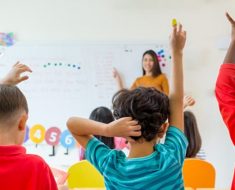Children with brain injuries face significant challenges when transitioning from hospital or home to school where they face issues such as lack of educator understanding and catching up with missed work. In the current issue of NeuroRehabilitation, leading researchers in the field of pediatric brain injury from across the globe identify today’s key issues in supporting children and youth with brain injuries as they transition to school or college.
The number of children with traumatic brain injury (TBI) and acquired brain injury (ABI) continues to grow globally. In the US alone each year, approximately 700,000 children up to the age of 19 sustain a TBI requiring hospitalization or emergency treatment. The effects of pediatric TBI and ABI affect every aspect of functioning—cognitive, behavioral, and social.
“TBI was added as a special education eligibility category under the Individuals with Disabilities Education Act (IDEA) in the US more than 25 years ago,” note Guest Editors Roberta DePompei, Ph.D., Distinguished Professor (retired) at the University of Akron, and Ann Glang, Ph.D., Director of the Center on Brain Injury Research and Training, University of Oregon. “Since that time, there has been an increasing awareness of the needs of children with TBI when they return to school. However, many of the same challenges identified in the 1990s still exist today across the world.”
This special issue describes many of these challenges and highlights key approaches for developing more effective supports for these students.
Mark A. Linden, Ph.D., School of Nursing & Midwifery, The Queen’s University of Belfast, Northern Ireland, and colleagues review evidence-based educational interventions for students with ABI.
“The education setting is increasingly recognized as a key contributor to post-injury rehabilitation in children and adolescents. It is a natural environment where children’s social, behavioral, and academic needs are met,” explains Dr. Linden. “However, to date, interventions have appeared to focus on the deficits of the child rather than key environmental influences such as school resources and policy, teacher training and education, identification and tracking.”
This review and meta-analysis focuses on educational interventions that impacted academic achievement in children following ABI. Researchers searched six online databases and found only four studies that had rigorously tested an intervention. Meta-analysis showed that overall these interventions were not effective at improving academic achievement.
The results suggest that there are no current, rigorously tested interventions that improve academic achievement in children following brain injury and that pooled data from included studies failed to show improvements on measures of attention, internalizing, or externalizing behaviors.
According to Dr. Linden, “If the academic needs of children with ABI are not being met at school, this has clear implications for achieving qualifications, occupations, higher education, and even housing. This places these individuals at severe economic and social disadvantage and increases their vulnerability. This research highlights the need for greater efforts to improve academic achievement in children following ABI.”
Transition from high school to college is often difficult and many students with TBI are unsuccessful in their attempts to do so. Mary R. T. Kennedy, Ph.D., Professor and Chair, Communication Sciences & Disorders, Crean College of Health & Behavioral Sciences, Chapman University, Irvine, CA, and colleagues outline a series of cases that provide insight into how supports during the transition from high school to college can be provided.
In a pilot study, five college students with TBI were coached to use self-regulation strategies while transitioning into or back to college. The students ranged from 19 to 24 years in age and included a college freshman, a sophomore, two juniors, and a senior. Researchers used semi-structured interviews to identify self-regulated learning strategies, demonstrate the utility and reliability of coding self-regulated learning strategies, and provide examples of student-centered goals derived from survey and interview responses.
The College Survey for Students with Brain Injury (CSS-BI) was used to identify challenges that students face. Interview questions were based on survey responses and specifically asked about strategies that students used both before and after coaching support. Strategies were described using the self-regulation schema developed by Zimmerman and Martinz-Pons (1986) and were reliably coded into 16 categories of self-regulation. Inter- and intra-reliability were strong. After coaching, four out of five students used a wider variety of self-regulation strategies and described strategies with more specificity. Coaches and students used interview responses to create client-centered goals.
“Self-regulation is associated with academic achievement, persistence and the ability to accomplish goals,” explains Professor Kennedy. “An important aspect of self-regulation is knowing which strategies will help one reach their goal. When students with TBI and professionals work together to identify strategies, students with TBI are more likely to make effective strategy decisions on their own.”
This preliminary study shows professionals not only what self-regulation outcomes look like, but also how to collaboratively identify outcomes with their clients. Ultimately, students who learn to self-regulate can rely on themselves rather than relying on others.
Source: Read Full Article





